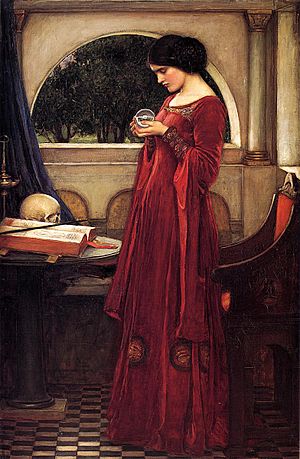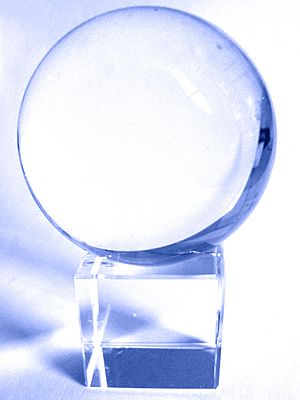Crystal ball facts for kids

A crystal ball, also known as an orbuculum or crystal sphere, is a crystal or glass ball and common fortune-telling object. It is generally associated with the performance of clairvoyance and scrying in particular.
In more recent times, the crystal ball has been used for creative photography with the term lensball commonly used to describe a crystal ball used as a photography prop.
Contents
Art of scrying
The art or process of "seeing" is known as "scrying", whereby images are claimed to be seen in crystals, or other media such as water, and are interpreted as meaningful information. The "information" gleaned then is used to make important decisions in one's life (i.e. love, marriage, finances, travel, business, etc.).
When the technique of scrying is used with crystals, or any transparent body, it is known as crystallomancy or crystal gazing.
In stage magic
Crystal balls are popular props used in mentalism acts by stage magicians. Such routines, in which the performer answers audience questions by means of various ruses, are known as crystal gazing acts. One of the most famous performers of the 20th century, Claude Alexander, was often billed as "Alexander the Crystal Seer".
Properties
A crystal ball is essentially a bi-convex spherical lens with a uniform radius of curvature, although without its edges and center material truncated as in a conventional lens construction. Thus the principles of optics may be applied to analyze its imaging characteristics.
As a lens, a transparent sphere of any material with refractive index greater than one bends rays of light to a focal point. An image is formed with significant coma, field curvature, and other optical aberrations inherent to spherical lenses. The refractive index of typical materials used for crystal balls (quartz: 1.46, window glass: 1.52), produces a central focal point just outside the surface of the sphere, on the side diametrically opposite to where the rays entered.
For materials with refractive index greater than 2, the focus will be located inside the sphere. In this case the image is not directly accessible, while the closest accessible point is on its surface directly opposite the source of light. However, few materials have a refractive index this high. For a refractive index of 2, the image forms on the surface of the sphere, and the image may be viewed on an translucent object or diffusing coating on the imaging side of the sphere.
Since a crystal ball has no edges like a conventional lens, the image-forming properties are omnidirectional (independent of the direction being imaged). This effect is exploited in the Campbell–Stokes recorder, a scientific instrument which records the brightness of sunlight by burning the surface of a paper card bent around the sphere. The device, itself fixed, records the apparent motion and intensity of the sun across the sky, burning an image of the sun's motion across the card.
The omnidirectional burning glass effect can occur with a crystal ball that is brought into full sunlight. The image of the sun formed by a large crystal ball will burn a hand that is holding it, and can ignite dark-coloured flammable material placed near it.
See also
 In Spanish: Bola de cristal para niños
In Spanish: Bola de cristal para niños


